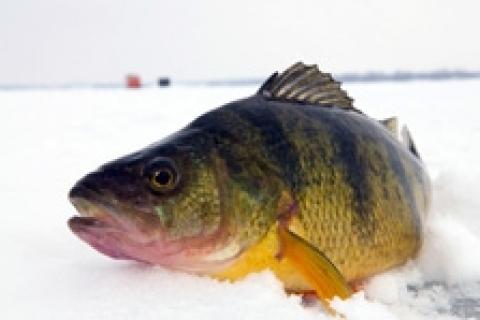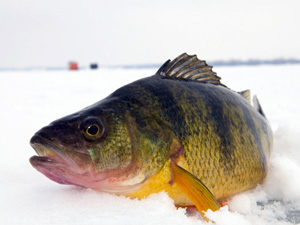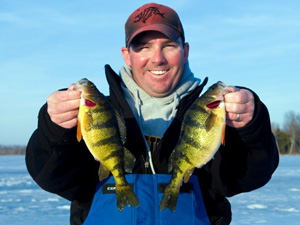
 Flats, as their name suggests, are relatively uniform; however, within them subtle structure and cover variances exist. These more diverse sections combined with an array of forage are what attract perch to these areas in winter. Pinpointing perch location can take time, but once found the action on flats can be fantastic.
Flats, as their name suggests, are relatively uniform; however, within them subtle structure and cover variances exist. These more diverse sections combined with an array of forage are what attract perch to these areas in winter. Pinpointing perch location can take time, but once found the action on flats can be fantastic.
Winter Phase Rundown
At first ice, perch can be scattered anywhere, but by mid-winter most will be on mid- to deep flats. They'll stay there until the last weeks of the season, before moving close to their spawning sites. Shallow flats, weedy bays and reedy shorelines will produce some of the year's best perch fishing during ice out.
Tucker on the Tablelands
Minnows and juvenile sport fish move to deep flats in winter to escape the inhospitable shallows that contain the coldest water in a lake and, in some cases, extremely low oxygen levels due to such factors as plant decomposition. Jumbo perch in particular will prey on these pint-sized fish. Perch will also gorge on crayfish, freshwater shrimp, nymphs, and larvae living on soft-bottom flats. But food isn't the only reason perch aggregate on these dishpan areas.
On the Look-Out
Inhabiting flats is a survival tactic for perch as the open space gives them an unobstructed view of approaching predators. This makes it tough for walleye, pike and lake trout to ambush the group. Granted, perch will still be hunted and an unlucky few will get caught, but statistically the school has better odds of surviving on a flat than on a hump or a point where they're more vulnerable to being trapped.
They Went That Way!
Perch on flats are often nomadic and drilling plenty of holes is essential to tracking them down. A 5-inch hand auger is great at the season's start, but a power model makes for faster and more efficient hole drilling as ice gets thicker. When prospecting, drill holes in a zigzag or linear sequence roughly 25 feet apart. Fish them quickly, moving every three minutes until a portable sonar displays fish and you catch one. Then drill out the area and fish it thoroughly.
The Devil's in the Details
Perch often relate to variances in a flat's uniformity, so be on the lookout for anything out of the norm. For example, small depressions will collect plant material and other debris that serve as habitat and food for invertebrates, like bloodworms. Finding these potholes can put you on perch.
On several lakes I fish a sand/weed edge is a prime zone. Perch regularly cruise the perimeter looking for crayfish and bugs. A rock pile or gravel bed surrounded by sand or muck is also good as perch often loiter around these hard-bottom deposits.
Finding these nuances takes time. In clear, shallow water I've spotted them looking down ice holes, while in deeper water a sonar or an underwater camera are the tools of the trade. Once found, store the hotspots in a handheld GPS.
Eating on the Run
Bear in mind that forage influences perch movements. On areas with lots of bottom-dwelling food, like bloodworms, and when their abundant forage moves slowly, such as freshwater shrimp, perch will lounge in an area and eat their fill. Hole hopping with a rod and sonar in hand is an easy way to track the school's lazy grazing in the immediate area.
 |
| Steve Barnett with proof that sand-weed transitions are hotspots for jumbo perch in winter. |
Perch are a different breed though when chasing minnows and young-of-the-year baitfish. They'll quickly pursue their prey, and being mobile and working as a team is essential to tracking the school.
Lures for Looking
When searching flats use big, boisterous baits to pique perch curiosity. A rattle spoon, jigging minnow or darter fished on a 26- to 28-inch, medium-light powered rod with 4-pound test line is a great set-up.
Jig the bait fairly assertively through the bottom half of the water column, creating a ruckus to try and attract perch from a wide area. Banging the bait on bottom will form a silt cloud. This replicates the disturbance caused by perch eating off the floor and often captivates nearby fish eager to join in on the feasting.
The greater the distance from which you can attract fish, the more water you can cover in a day. They might not bite the bulky bait, but once perch show themselves you can then adjust tactics to trigger strikes.
Serving Up Snacks
When perch are selective, cycling though baits and experimenting with jigging moves will put fish on the ice. Downsizing to a 1- to 1.5-inch spoon, jigging minnow or darter along with light lifts and long pauses is sometimes all it takes to get a bite. Adding bait also helps. Dressing the hook with a minnow head or a piece of tail meat adds scent and acts as a bullseye for fish to focus their attack.
When hard-bodies aren't working try a soft touch. The latest generation micro-plastics feature squishy bodies and flimsy appendages — the perfect winter snack. Many are moulded into realistic decoys of various perch delectables, such as freshwater shrimp, bloodworms, nymphs and crayfish. Use subtle swimming motions, avoiding bouncy, erratic maneuvers.
Tiny ice jigs are indispensable when up against lock-jaw jumbos. On several tough bites dead-sticking a small maggot-tipped jig in the muck has helped me put fish on the ice when all else failed. This is painstakingly slow fishing, but sometimes it's the only option when fish are choosy.
Light and ultralight rods outfitted with 2- to 3-pound test line are best to present micro-plastics and ice jigs. A well-balanced set-up is crucial to imparting faint movements when jigging and detecting a light bite.
Final Thoughts
Given their size and limited features, flats offer unique challenges. Hours can pass without a glimmer of life, but when the sonar lights up after moving to a new hole you'll reap the rewards of being persistent for perch on flats.
- 13736 views

